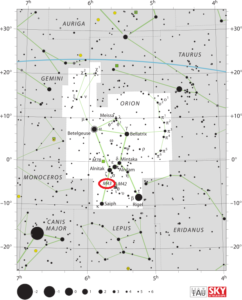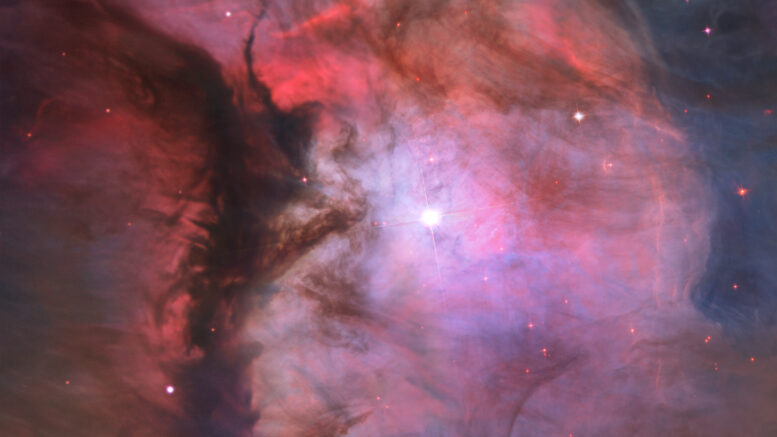Messier 43 or M43, also known as De Mairan’s Nebula and NGC 1982, is a star-forming nebula with a prominent H II region in the equatorial constellation of Orion. It was discovered by the French scientist Jean-Jacques Dortous de Mairan some time before 1731, then catalogued by French astronomer Charles Messier on March 4, 1769. The De Mairan’s Nebula is part of the Orion Nebula, Messier 42, being separated from the main nebula by a dense lane of dust known as the northeast dark lane. It is part of the much larger Orion Molecular Cloud Complex.
| Description | |
| Visible From Pacific Northwest | October To February |
| Best Time To Observe | December and January |
| Minimum Size Of Viewing Device | Binoculars/Small Telescope |
| Object Type | Nebula with open cluster |
| Designations | Messier 43, M43, De Mairan’s Nebula, NGC 1982 |
| Right Ascension | 05h 35.6m |
| Declination | -05°16′ |
| Constellation | Orion |
| Apparent magnitude | +9.0 |
| Apparent dimensions | 20′ x 15′ |
| Object Radius | 4.5 light years |
| Distance From Earth | 1,600 light years |
History
De Mairan’s Nebula was named after Jean-Jacques d’Ortous de Mairan, the French astronomer who discovered it before 1731.
Charles Messier catalogued De Mairan’s Nebula and the Orion Nebula on March 4, 1769, but assigned them separate numbers.
William Herschel added De Mairan’s Nebula to his catalogue as H III.1. Herschel first saw M43 on March 4, 1774 and catalogued it on November 3, 1783.
John Herschel added M43 to the General Catalogue as GC 1185. He described it as “remarkable, very bright; very large; round, with a tail; much brighter toward the middle where there is a star of 8th or 9th magnitude.”
The first deep image of the Orion Nebula, taken by Henry Draper on March 14, 1882, also shows De Mairan’s Nebula.
Locating M43 In The Sky
De Mairan’s nebula lies to the north of M42 and is considerably fainter than the larger nebula. This small star cluster accompanied by an emission/reflection nebula just to the north of the Orion Nebula’s “Trapezium” region is often mistake for part of the great nebula itself. However, if you look closely, you’ll see the two are separated by a dark dust lane.
Begin by locating the asterism of three stars known as Orion’s Belt. If you cover it with your fist held at arm’s length in a “thumb’s down” gesture with your left hand, the tip of your thumb will just about mark the correct spot in the sky.

Viewing M43
De Mairan’s nebula lies to the north of M42 and is considerably fainter than the larger nebula. It can be seen in binoculars and small telescopes, but the smoky wisps and the dark features along its eastern border are only visible in larger instruments, starting with 8-inch telescopes.
In 10×50 binoculars, the nebula appears like an elongated patch with a bright centre. The central star can easily be seen in binoculars. The dark lane that separates M43 from M42 is revealed in small telescopes. The best time of year to observe M43 is in the winter months, when Orion is prominent in the evening sky.
Photographing M43
M43 is the little ball shaped nebula on the left of the heart shape of M42 in some photographs. Therefore, the best way to image M43 is to utilize the settings for photographing Messier 42. Check out the Messier 42 article for more details, but we will add in a little snippet.
This means that a typical imaging session of M43 and the surrounding area will involve photographing several long exposure images that can later be registered and stacked to produce a final image with a healthy signal-to-noise ratio. In general you want the lens to gather as much light as possible in a single shot.
https://www.galactic-hunter.com/post/m42-the-orion-nebula
Sources And Further Reading
Descriptions of all of Messier Objects can be found here.

Be the first to comment on "Messier 43 De Mairan’s Nebula"